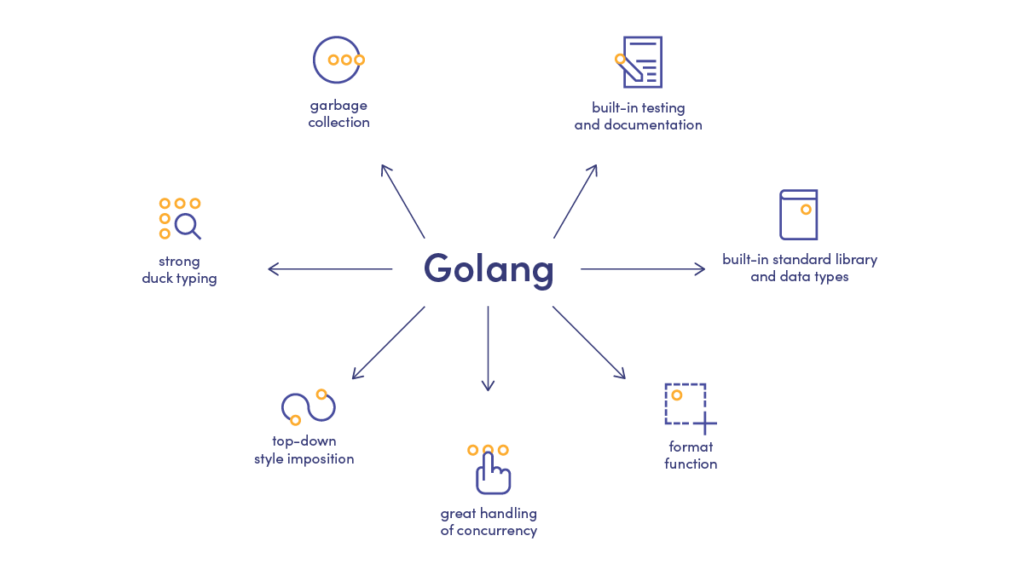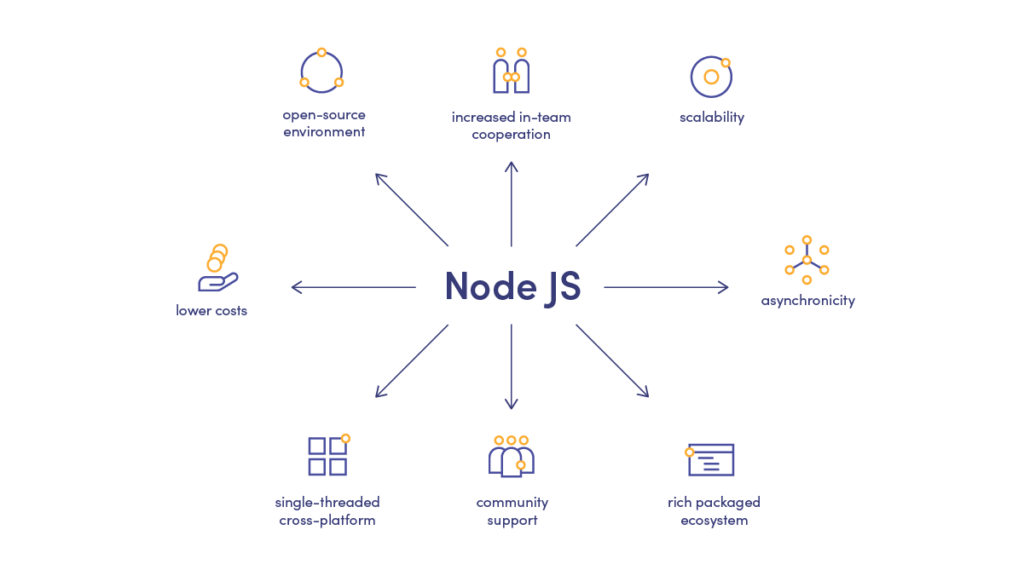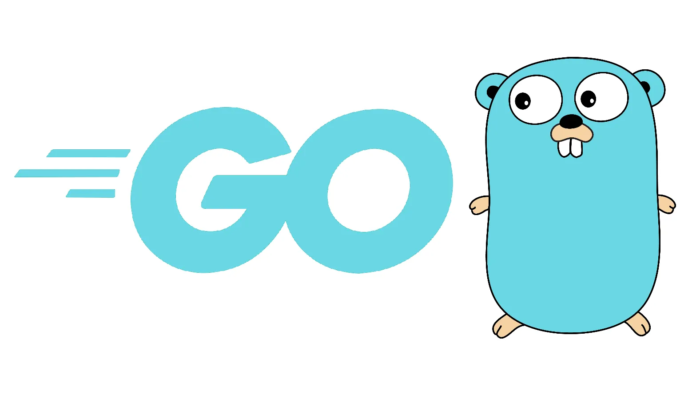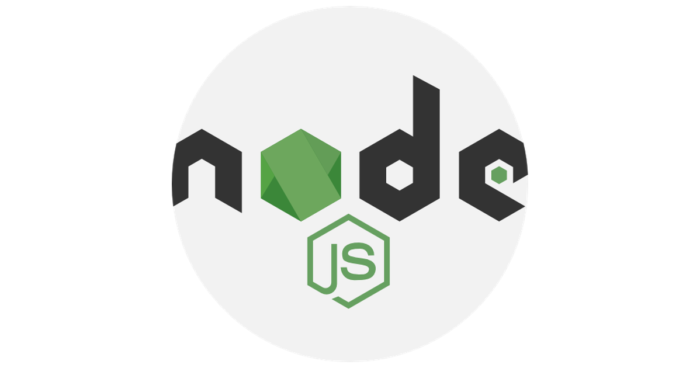In the Node.JS vs Golang duel, the first one has taken over the front long ago. However, Golang has quite a large group of staunch supporters as well. Our Golang-Node JS comparison might be helpful in solving the dilemma of choosing the platform for your next project.
It’s no mystery that adjusting the language to the specifics of the project is the key to success. Nevertheless, despite appearances, making a choice can be a hard nut to crack – even for experienced developers. Knowing what challenges and opportunities come with a particular language can save you some worries (not to mention costs).
In this article, we’re going to look into the core advantages of each language for mobile and web app development, their applicability for cloud storage, map computing, and machine learning.
By the end of this post, you’ll have all the essential info to make up your mind and choose the most suitable language for your next project!
What is Golang?
Golang was created a few years earlier than Node JS – initially for the purposes of Google. It is a simple, general-purpose, open-source programming language appropriate even for beginners. According to the words of one of its creators, Rob Pike, Go is supposed to combine the safety and performance of statically compiled programming languages with the lightness of the dynamically RTP’d ones.
It’s all good and all, but there is one question that keeps developers awake:
Is Go a functional language?
Golang can be considered rather procedural. Since it excludes exceptions, object constructors, and class inheritance, it is not object-oriented either.
Considering its structure and a few useful features discussed below, it definitely can be seen as a practical and efficient choice. Some could even say boring. However, from our perspective, it is actually an advantage in particular cases.
Go’s growing popularity in recent years proves that it solves the problems that the other languages pose, such as memory leaks or slow processing, just to name a few.
Does it mean Golang is actually better than Node JS? We will try to answer this question in the following paragraphs by analysing its specific features and structure.
Main advantages of Golang
In general, Golang limits the number of necessary actions and decisions, which makes it simpler than other languages.
Among other benefits, Golang is second to none when it comes to concurrency. Besides that, this language features built-in testing, documentation, standard library, and data types. Furthermore, Go handles garbage collection, duck typing, and automatic code formatting really well.

As a result of being simple and intuitive, it’s also easy to learn. Those who already have Java, JS, and other languages at their fingertips will perfect Go in the blink of an eye. Even for beginners, it usually takes no more than two weeks to achieve fluency.
Golang app examples
Golang web programming is eagerly used in polyglot apps, together with JS and other languages. Successful startups treat it more like handy support in case there is a need for quick and efficient problem solving and implementing improvements in their apps.
Go web development was used for the architecture of Booking.com, SoundCloud, PayPal, Allegro, Skyscanner, and Twitter, among others.
How about a Golang web app example made from scratch with this language? Monzo, an online banking app, is a good one. Even our own Timesheets, written initially for internal purposes of Miquido, was developed using Go. We have a good reason to advocate for Golang – for us it turned out to be very efficient. The result was so satisfying that we decided to share it with others, releasing the platform to the market.
What is Node?
Among over 700 existing programming languages, JavaScript is considered one of the most popular, if not the most popular one, reaching the top of annual rankings and followed by Python, Java, and CC. Golang is less successful in this regard. However, when comparing the trends in programming from the previous years, you may notice that it has strengthened its position, nipping at the heels of JS and company.
What would happen if you combined JavaScript with asynchronous IO and HTTP server elements? Ryan Dahl decided to check it out, and that’s how Node Js – a platform that enables using JavaScript in other environments than a web browser – was born.
Developers love Node JS
There are various reasons why such giants as Airbnb, Netflix, Twitter, or LinkedIn have placed their bet on Node JS development. We’ll have a deeper look into all the perks this language brings to the table, but there’s one that definitely takes the lead – synchronicity.
After Node JS was introduced, the devs who had already been operating JavaScript for the front-end got an opportunity to smoothly switch to the back-end, creating complete web apps within one language framework. The results? Faster and more efficient development of IT products.
But wait, cuz there’s more!
Advantages of Node JS
Before Node JS was introduced, JavaScript was a typical client-side development tool – a quite successful one, to be fair! But it was only after its introduction that the devs’ work became significantly simplified due to easy synchronization of backend and frontend.
Let’s not overlook the community aspect, which makes problem-solving in the Node environment easier due to numerous open-source guides and ready-made solutions. The developers can discuss their doubts and share solutions through the OpenJS Foundation Slack, which gathers a large community of Node JS users and educates with free tutorials.
From the perspective of an investor, choosing this open-source runtime environment can be a way to increase the effectiveness and tempo of the team’s work. The devs appreciate its scalability, lightness, and richness of the packaged ecosystem. Let’s not forget, however, that it is not a perfect solution.

Node JS issues
As a single-threaded cross-platform, Node JS is a perfect choice for IO intensive and non-blocking apps such as web and real-time servers or command-line utilities. Its asynchronicity excludes the necessity to wait for the response from the server – you can move on to the next command.
However, the concept of the event loop it uses may turn out to be quite problematic. As every new event is sent to the end of the queue, the processing becomes slower. That explains why Node JS will not really be the greatest match for processor-intensive operations.
Go vs Node JS in web development
If you want to build a powerful web application, you might consider using one of these languages for effective support of your master code. Let’s have a look at some major decisive factors that should help you make up your mind once and for all.
Golang for simpler code
Golang for web is used mostly in backend development, which doesn’t mean that it cannot serve for frontend-related tasks. Unlike the scripting languages used in web development – including PHP, JS, Ruby, and others – Golang uses compiled code, which makes it run faster.
Developers who have decided to give Go a chance point out that migrating to it enabled faster coding and elimination of bugs, as well as problems with processing and finding memory hogs. Golang web development can also help you eliminate typing issues and inconsistencies in the style of the code. It automatically cleans up and scales well.

Source
Node JS for scalability
You already know what makes the majority of developers so attached to Node JS. Now, what about the investors? In their case, great scalability and performance are what matters the most. If you are developing a web app that is supposed to be a subject of dynamic changes and improvements, Node JS is what you need. But as we’ve mentioned before, it may not be the best fit for the apps that require heavy data processing.
From the company’s perspective, investing in Node almost always equals the reduction of costs since the same language covers the back-end and front-end. This way, you can hire fewer professionals with the same effect. Its events-based nature, however, excludes successful application wherever intensive data-processing is involved.

Source
Node JS and Golang in mobile development
As backend solutions, Node JS and Go won’t do for writing mobile apps – at least, not literally. After creating a mobile app, you can connect it to the existing backend developed in Node JS or Golang via HTTP protocol. Both Golang and Node JS can be paired with React Native or Flutter to build apps for Android and iOS.
For cross-platform development, you can use GoMobile – a tool written in Go. Using a “gomobile bind” command allows you to create a library for Android and iOS by generating language bindings or writing an app entirely in Go.
Node JS and Golang in cloud computing
Both Node and Golang can be hosted basically everywhere. The choice depends on many variables, such as the range of costs you are willing to accept, or the size of your project. It can be AWS, as well as Google App Engine, Google Compute Engine, Azure, or Digital Ocean.
So, when choosing cloud-based solutions, just go with your gut, or, better yet, consult your doubts with our development team. Just reach out and get all the answers!
Maps in Golang and Node JS
Maps in Go are hashmaps, very similar to ones used in Python or Node JS. As a data structure, a map in Golang is an unordered collection of key-value pairs, with a unique value for each. It’s useful for storing information and finding it. When it comes to Node JS, the mechanism of storing data is very similar.
When processing large quantities of data, using the hash map is the best solution. As an algorithm, it enables efficient scanning of long lists of items, faster than a search tree due to its array structure. Hash maps require more memory than other types of search, but they’re unbeatable in terms of dealing with large sets of data.
Machine learning with Golang and Node JS
For Golang Machine Learning, TensorFlow is worth consideration. It’s an open-source library that enables numerical computation. However, the API provided for Go won’t allow training models – users of Go can only use trained ones. For defining and training the models, most Go-phers use Python, uploading them later to Go.
With the use of Node JS, you can generate models and train them from the very beginning, but also reuse the trained ones. In its case, TensorFlow will be a perfect choice, too. The key to effective machine learning development in Node JS is the good library supplies.

Neither JavaScript nor Go is the first choice of the teams that work with machine learning. There are numerous ready-made libraries for Python and other languages, while Go and JS require more work.
However, they both can be an effective alternative if applied thoughtfully.
Can migrating to Go be profitable?
Now, let’s talk about money – even the best ideas need a thoughtful financial plan to turn into successful IT products. Previously, we have mentioned that choosing Node JS can be cost-effective.
However, switching to Go can help you save even more in the long run.
Why? First, new devs can learn it in a shorter time and be more productive with it. Second, Golang may help with putting out the fires during all stages of the project. Additionally, its low memory footprint equals saving money on servers.
Summary
Both platforms have pros and cons, broadly described above. It’s hard not to notice that in the category of intensive data processing and server-side development, Go is second to none. However, it has its limits.
It is not uncommon for devs to lose their skeptical approach to Go after experiencing the full range of its benefits firsthand. Even though Node JS is an undisputed leader in the rankings, Golang is not in any way inferior. Quite the contrary, it often helps with solving the problems generated by Node.
Miquido’s team can help you choose the right language for your next project – get in touch with our backend development company!









